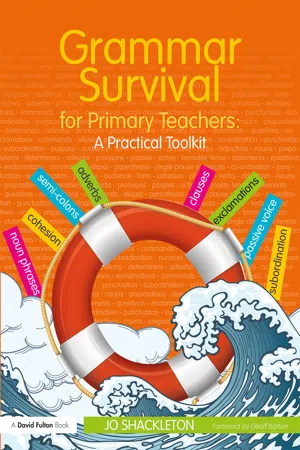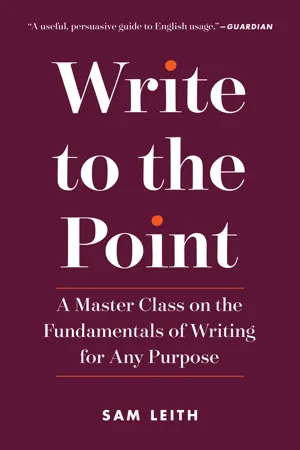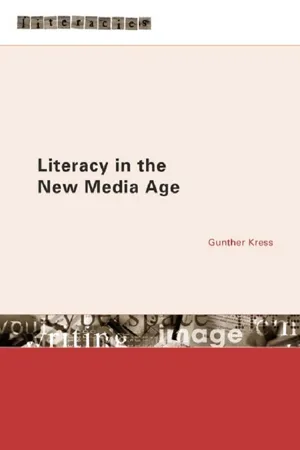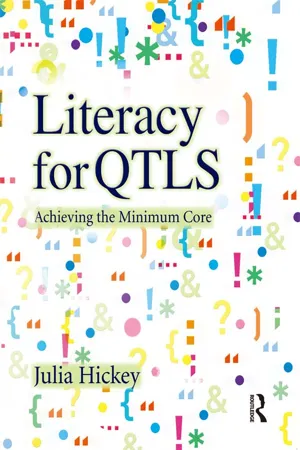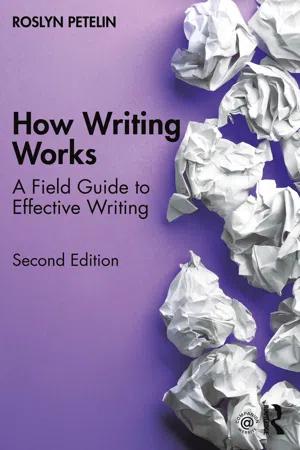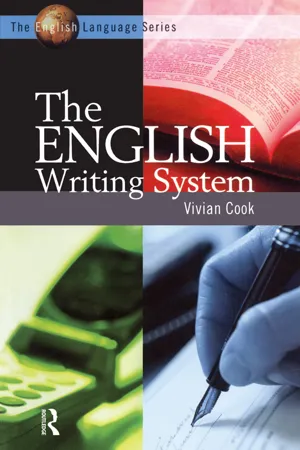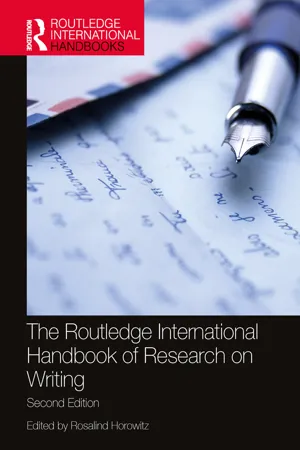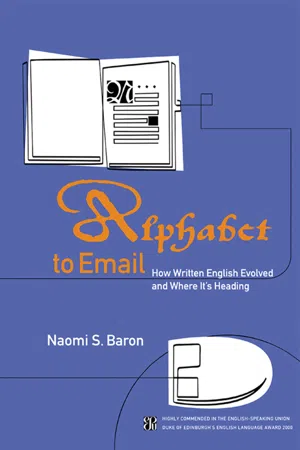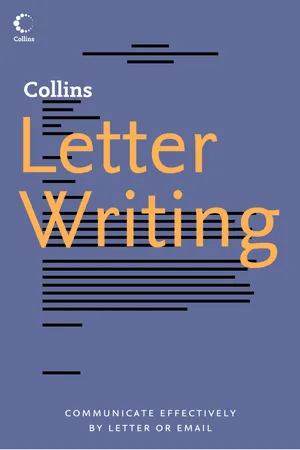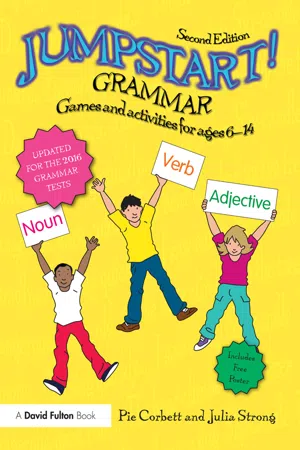Languages & Linguistics
Punctuation
Punctuation refers to the marks used in writing to clarify meaning and indicate pauses or breaks in a sentence. These marks include commas, periods, question marks, exclamation points, and more. Punctuation is essential for conveying the intended tone, structure, and clarity of written language.
Written by Perlego with AI-assistance
11 Key excerpts on "Punctuation"
- eBook - ePub
Grammar Survival for Primary Teachers
A Practical Toolkit
- Jo Shackleton(Author)
- 2017(Publication Date)
- Routledge(Publisher)
You could say that we’ve come back to where we started, with website addresses now omitting spacing between words and some text messaging omitting Punctuation altogether. Some Punctuation marks are less widely used today than in the past, while new ones are appearing, such as the inventive and personalised use of emoji and emoticons.Punctuation is perhaps best seen as a set of conventions. Although there are rules, there is still disagreement about some of them, such as the use of the serial comma. And much Punctuation usage does come down to personal and stylistic choice – for example, whether we favour a ‘heavy’ or ‘light’ approach to Punctuation. Numerous style guides have their say too.Some Punctuation continues to confuse writers well into adulthood (think of the ‘greengrocer’s apostrophe’): such visible errors can invite scorn and lead to talk about falling standards. Others take a more liberal approach to Punctuation: text messaging often leaves out Punctuation completely, as does some critically renowned poetry. However, if we’re going to break the rules or adapt the conventions for literary and creative effect, or simply for economy, we need to know what they are in the first place.p.69 APPLICATIONTeaching about PunctuationPunctuation, along with spelling and capitalisation, comes under the definition of orthography rather than grammar, as it has more to do with the way we write things down than the structure of the language itself.When we talk, we can pause, repeat things and clarify our meaning in response to feedback from our listeners. We can use intonation to convey nuances of meaning. We don’t necessarily speak in sentences, but more typically fragments composed of single words, phrases and clauses.However, when we write, we use the convention of Punctuation to guide our (usually unknown and remote) reader, to help them navigate our writing and understand what we mean to say. Commas and hyphens, for example, both play an important role in clarifying meaning and avoiding ambiguity. Think about the difference the hyphen makes in ‘man-eating shark’, and the impact of the commas on the meaning of these two sentences: - eBook - ePub
Write to the Point
A Master Class on the Fundamentals of Writing for Any Purpose
- Sam Leith(Author)
- 2018(Publication Date)
- The Experiment(Publisher)
It’s worth starting by thinking about exactly what Punctuation is for. It’s one of the things, along with word order and morphology (the way words change their forms and endings), that help orient the words in a sentence. Punctuation marks are signposts through a sentence. Some of them inflect a sentence’s tone or meaning: A question mark or an exclamation point change what you might think of as a sentence’s tone of voice. Some of them denote a relationship between one part of a sentence and another: Brackets tell you that what’s in them isn’t part of the main flow of the sentence; a colon signals that what comes after it elaborates or depends on what goes before.Originally, though, Punctuation began as a device used by scribes to help people reading aloud know where to pause. The big four marks—the comma, the semicolon, the colon, and the period—were primarily understood to denote the length of a pause, with a period in some accounts of it four times as long as a comma. But those marks were taken up by printers and grammarians and repurposed as aids to semantic understanding. In effect—as with many other features of the language—prescriptive grammarians attempted to fold them into a logically consistent system. So Punctuation now plays two parts: It both marks time for the reading voice and signposts grammatical relationships. Many of the arguments about Punctuation arise from the overlap between its two functions. A comma can be there simply to mark a pause—but it can also have a role in marking a parenthesis or separating two clauses. As the linguist David Crystal writes in his book Making a Point: The Pernickety Story of English Punctuation: “This is where we see the origins of virtually all the arguments over Punctuation that have continued down the centuries and which are still with us today.”Punctuation is also subject to fashion. We live in an age that favors light Punctuation. We use fewer commas than our forebears. We omit periods at the ends of sentences in many circumstances—in the titles of books, on signposts, and in text messages or social media posts. We are more likely to do away with hyphens when writing compound words—preferring “semicolon” to “semi-colon,” for instance. - eBook - ePub
- Gunther Kress(Author)
- 2003(Publication Date)
- Routledge(Publisher)
I take it for granted that speech and writing are modally distinct. However, the relation between speech and writing is constantly present, is constantly active, and can constantly be activated in particular ways in relation to specific purposes. The new environments for writing, in which multimodality and the new dominance of the screen on the one hand and changes in social power on the other are pressing in on the organisation of writing as a mode, have as one consequence that the interrelations of speech and writing are newly put into flux. We need to understand what the principles of that relation are in order to focus on those which remain as constants. This will allow us to understand in what ways the principles are used now.One significant dimension of Punctuation is as the marker of the relations of speech and writing, whether as a translation, transformation or transduction from the one to the other. For those writers—I include myself among them — who have it as a social aim to write in a more speech-like manner, Punctuation has a crucial place in translating from one system of framing, that of speech (through pacing, intonation, accent), to another system of framing, that of writing (through word-order, embedding, Punctuation); this applies equally to those writers who write with the cadences of speech in mind while they are writing.The shift from speech to writing involves a shift in ‘logic’: a shift from the logic of sequence in time to the logic of arrangements in (conceptual, visual and other) space. This necessarily involves a change in the resources of framing. I can also express this as a move from frames that rely predominantly on the use of the voice — as stress or rhythm, and as pitch or intonation — to frames that use the affordances of sequence — syntax. It is a move from clearly discrete linked clause-elements to (clauses in) highly integrated sentence structures. It is a move from the overt lexical (and, so, then, therefore - eBook - ePub
Literacy for QTLS
Achieving the Minimum Core
- Julia Hickey(Author)
- 2013(Publication Date)
- Routledge(Publisher)
6 Punctuation As a trainee working towards QTLS and also as a professional working in a teaching and learning environment it is important to punctuate work correctly. Tutors are expected to be able to support their learners as they develop the essential communication skills that they will require to succeed in their own learning. Your subject specialism may not be English but if your learners need to put pen to paper you will need to be able to: assess that they have used Punctuation to make their meaning clear; support learners who have gaps in their knowledge of Punctuation; work with specialist staff to support learn-ers who have Punctuation needs identified on their individual learning plans. These expectations mean that you need a clear understanding of the basics of Punctuation. Punctuation The signposting device for the written word. Minimum core elements A2 • Knowledge of how textual features support reading. • Developing spelling and Punctuation skills. Part B Personal Language Skills • Use spelling and Punctuation accurately in order to make meaning clear. Overview Punctuation is the device by which words are divided into groups that have meaning either by separating words into sentences or by linking words, clauses and phrases together. Ideas will be better understood if the Punctuation is effective. Commas, semi-colons, colons, full stops, question marks and exclamation marks change the rhythm, pace and tone of spoken words as well as separate words, phrases, clauses and sentences on paper. Punctuation gives written words the structure and meaning that pitch, tone, pace and facial expression give to speech. Put simply, Punctuation places strings of words into meaningful groups. Fluent readers skim across sentences to identify the Punctuation marks to find out how a sentence should be read - eBook - ePub
How Writing Works
A field guide to effective writing
- Roslyn Petelin(Author)
- 2021(Publication Date)
- Routledge(Publisher)
CHAPTER 6 How Punctuation worksDOI: 10.4324/9781003179344-6Roslyn PetelinPunctuation marks are the stitches that hold the quilt of language together.Theodor Adorno[Punctuation marks are] cues to the reader for how very quickly to organize the various phrases and clauses of the sentence so the sentence as a whole makes sense.David Foster Wallace and Bryan GarnerPunctuation is more than just a game for pedants. It’s vital to convey meaning.Harry MountWhy punctuate?
Because excellent Punctuation demonstrates our command of sentence structure, grammar, and style, we need to take Punctuation seriously. Punctuation illuminates the structure/topography of our writing for our readers. Clear structure clarifies the meaning of our writing. You need to learn how Punctuation marks reveal structure and relationships between words in a sentence and, in doing so, clarify meaning. You can have a grammatically incorrect sentence that’s perfectly punctuated, but you can’t have an incorrectly punctuated sentence that’s perfectly grammatical. Learn to use specific marks in an informed way; study sentences in well-punctuated prose to learn the particular marks. You could start with this book. Construct your own set of guidelines for punctuating based on the material in this chapter. At the conclusion of this chapter, Figure 6.2 presents a set of sentences that demonstrates the Punctuation patterns for the main Punctuation marks.Punctuation should be there quietly doing its job, not drawing attention to itself, and consistently indicating connections between words and ideas. The earliest form of Punctuation was a space between words. Each Punctuation mark should convey a signal to your reader that is noticeable only to Punctuation vigilantes. The American novelist Ernest Hemingway, renowned as a sparse stylist, apparently never used the semicolon, but he doubtless knew it existed. The American writer Mark Twain is alleged to have sent his publisher a page of Punctuation marks for his editor to insert where needed, as a gesture of Twain’s disdain for Punctuation. The British playwright, poet, and iconoclast Oscar Wilde had such concern for getting his Punctuation perfect that he once said he spent a morning putting in a comma, and the afternoon taking it out. - eBook - ePub
- Vivian J Cook(Author)
- 2014(Publication Date)
- Routledge(Publisher)
written by linguists well-known in other areas. Even NASA feels it has to provide its own on-line Grammar, Punctuation, and Capitalization: A Handbook for Technical Writers and Editors (McCaskill 1998). Publishers want their names to be associated with Punctuation as conferring some seal of respectability and authority: there do not seem to be similar titles in other genres, say, correct pronunciation or proper driving. These manuals arise partly out of the tradition of publishing houses providing printer’s guides, say Hart’s Rules (1983) or Collins Authors’ and Printers’ Dictionary (1973). While it may be legitimate for publishers to maintain a consistent style in their own books, there is no reason why their opinion should count for other publications, let alone for ‘amateurs’ not aiming at print. Cameron (1995) provides an illuminating discussion of the ideology of such attempts to impose a ‘standard’ on English. 4.1 GRAMMATICAL AND CORRESPONDENCE Punctuation Focusing questions Why do you think Punctuation matters? What difficulties have you yourself had with English Punctuation? Is Punctuation primarily to do with reading aloud or is it something of its own? Key words Punctuation: ‘the rules for graphically structuring written language by means of a set of conventional marks’ (Coulmas 1996: 421). grammatical Punctuation: relates the written text to the grammar of the written language. correspondence Punctuation: relates the written text to the spoken language, as in reading aloud. Punctuation consists of the use of additional marks to the letters of the alphabet, such as the full stop <.>, the comma <,> and so on. Modern English uses more or less the same set of Punctuation marks as other languages. Nunberg (1990: 10) goes so far as to say that ‘there is only one system of Punctuation … which is used in all developed Western, alphabetic languages, subject to the fixing of a few parameters and the establishment of various local conventions and constraints’ - Rosalind Horowitz, Rosalind Horowitz(Authors)
- 2023(Publication Date)
- Routledge(Publisher)
Visible Language (1990) who also notes how little we know about the prescriptive explanations and development of uses of Punctuation. Most interesting is that while Hebrew historically used Punctuation, Greek and Latin manuscripts did not consistently use Punctuation (p. 55).A doctoral dissertation in Sweden has investigated the development of text production in writing and speech with attention to 10-year-olds through university students (Johansson, 2009 ), which warrants further follow-up to understand how learners understand text production differs from speech production. Studies across the world might look at how text production emerges, across university students and disciplines taking into account Punctuation as it bears on cognition—text understandings.Research in Brazil (Soncin & Tenani, 2017 ) revealed many errors in Punctuation when children, ages 11 to 14 transform speech to writing in grades equivalent to in the United States. These researchers argue that the errors noted in argumentation writing are symbolic of how children “hear language” and not to be viewed strictly as errors per se but means during childhood to apply sound to text. These errors may be recorded, tallied, and analyzed as an index of a child’s stage of development in speaking and writing with attention to Punctuation. The beginning of Punctuation in childhood has also been investigated by Ferreiro & Pontecorvo (1999) and Hall (2009) to examine stages of early development and its advancement.Macro-Strucrural Elements as Rhetorical Tools of Writing
Part II. Textual Design: Macrostructures in Academic Speaking and Writing
One of the most difficult tasks in academic writing is the creation of what Teun van Dijk (1980) has called the production of a macrostructure in discourse. This is a creation of the overall rhetorical form and purpose of a talk or essay. It is the “frame” that holds the message together, the thesis, similar to the roof of a house built by architects. These structures have also been referred to as “topoi,” “top-level structures,” “the gist of a text,” and “rhetorical predicates.” (Dick, 1964 ; Horowitz 1982 ; 1987 ). Van Dijk (1980)- eBook - ePub
Alphabet to Email
How Written English Evolved and Where It's Heading
- Naomi S. Baron(Author)
- 2002(Publication Date)
- Routledge(Publisher)
Use of grammars and Punctuation guides for training pupils to represent speech continued through the nineteenth century, supported by the efforts of professors of elocution. Early in the century, Alexander Bell (father of Alexander Melville Bell and grandfather of Alexander Graham Bell) emphatically proclaimed,It is certain, and cannot be denied, that the mode of Punctuation, at present in use, is worthless, in so far as it bears on Eloquence… Punctuation, is the art of dividing a written composition into sentences, or parts of sentences, by means of certain signs agreed upon, for the purpose of regulating the pauses of the voice in reading, and of rendering more intelligible, and perspicuous, the construction, and meaning of the sentences.59Strictly Grammatical Models
Only a few grammarians of the eighteenth and nineteenth centuries consistently advocated an exclusively syntactic model of Punctuation.60 One such figure was David Steel, author of Elements of Punctuation (1786), who protested thatGrammar, which ought to be the basis of Punctuation, has seldom been considered as adequate for the purpose: too much accommodation [is given] to the reader, and too little attention to grammatical construction.61Many other grammarians of the day appeared, at first blush, to be strictly syntactic in their approach to Punctuation. However, the vast majority found ways of recognizing a rhetorical role for Punctuation as well.Fence-Sitters
Perhaps the best-known grammarian of the era was Bishop Robert Lowth, author of A Short Introduction to English Grammar (1762). Lowth’s Introduction, along with Lindley Murray’s 1795 English Grammar, - eBook - ePub
One Day in the Life of the English Language
A Microcosmic Usage Handbook
- Frank L. Cioffi(Author)
- 2015(Publication Date)
- Princeton University Press(Publisher)
Chapter 4Punctuation, Part I—The Comma: Promiscuous UsesIntroduction: Punctuation Substitutes for Oral Emphases, Facial Expressions, and Body LanguageWhen people speak, they consciously and subconsciously use an arsenal of effects to get their points across. They might emphasize certain words, pronounce others slowly or in an animated way, pause, use hand and facial gestures, insert filler phrases such as you know or like. In fact, body language and facial expression—extralinguistic communicative actions—account for an enormous portion of communication, perhaps more than we realize. Psychologist Paul Ekman contends, for example, that the forty-three facial muscles convey the majority of a person’s emotional state and thus constitute a significant part of communication (Foreman).When we write, though, we don’t have the power to emphasize words in special ways or to slowly and carefully pronounce some and glide over others. We don’t have hand gestures when we write, or the ability to smile or frown or give the side-eye. But we do have something that’s invisible in speech. We have Punctuation.In the last hundred years or so in the United States, English Punctuation has become quite standardized. There are ranges of acceptable usage (for example, some writers tend to use a large but acceptable number of commas, while others prefer to give fewer cues as to how their sentences should be read. I’ve been accused of overusing semicolons and dashes. Who, me?). In general, Punctuation aids readers in understanding what you as a writer mean. You don’t want to confuse your reader or force that reader back to reread, especially when the simple insertion of a comma might ease straightforward, relatively unambiguous communication. In fact, sometimes a sentence with a comma can mean one thing, yet without that comma can mean the exact opposite. In legal writing, millions of dollars can hinge on a comma, which makes that little mark potentially a keystroke of great value. Or as the T-shirt would have it, - eBook - ePub
- (Author)
- 2013(Publication Date)
- Collins(Publisher)
The rules for Punctuation are conventions that have been developed through the centuries by printers and publishers and are simply devices for making written text easier to read and understand. Punctuation helps the reader to make sense of a large piece of written communication by breaking it down into smaller, more manageable, sections. It also helps to make the appearance of the written page clearer and more attractive. In speech, we can use gestures, give emphasis to a word, or raise and lower our voices to help illustrate our meaning. In written work, much of this stress and clarification must be accomplished by Punctuation.Some conventions of Punctuation are obligatory and some are optional, but they should all be used with discretion and good common sense. Sentences may be rendered meaningless by lack of Punctuation, or they may take on an entirely different meaning, and you should always attempt to use the correct Punctuation.THE FULL STOP
This is probably the most straightforward aspect of Punctuation. The full stop is used to separate one sentence from another. When you come to the end of a sentence, you use a full stop. If no full stops were used, a piece of text would be almost impossible to read or would mean something else entirely.EXAMPLE
The king walked around the castle an hour after his head was chopped off. The king walked around the castle. An hour after, his head was chopped off.The full stop may also be used after abbreviations such as B.A., H.M. and Co., but is omitted if the shortened word includes the last letter of the word, e.g. Dr, Mr and Ltd.THE COMMA
The comma lies at the place in the sentence where you would normally take a breath, or where there is a natural pause. It is the most frequently used Punctuation mark and has many functions. It is generally used: - eBook - ePub
Jumpstart! Grammar
Games and activities for ages 6 - 14
- Pie Corbett, Julia Strong(Authors)
- 2015(Publication Date)
- Routledge(Publisher)
Chapter 5 PunctuationThis chapter provides a wide range of talk-based activities to build children’s understanding of how Punctuation works and what sort of Punctuation is needed where. Some of these are aural activities because a good way to build confidence with Punctuation is to read text aloud, pausing appropriately at the Punctuation, to help children notice the difference Punctuation makes.What is Punctuation?The games below have been designed to help you draw out from the children that Punctuation is the use of symbols to separate off (or link together) words, phrases and clauses to help the reader follow the intended meaning of a text. The key Punctuation marks are full stops and commas : full stops separate one sentence from another, while commas separate off information within sentences. Brackets (commas or dashes) can also be used to separate off dropped in phrases or clauses within sentences. Separating off information in this way is known as parenthesis. Exclamation marks and question marks are a form of special full stop to indicate a different sort of sentence, as their names suggest. Colons introduce information; semi-colons can be used to separate off phrases or clauses, as illustrated in this sentence. Apostrophes indicate missing letters (omission) or possession. Finally, hyphens are used to join words or bits of words together – while dashes can be used informally to separate off clauses or phrases, as exemplified!Feeling the difference Punctuation makes
Young children like physically acting out the Punctuation in a text and it’s the perfect way to get them to remember that it is important. It’s the pattern of the sentence that makes the Punctuation meaningful so it is perhaps logical to teach the pattern of the sentences first, and then help the children understand how the Punctuation helps make the sentences meaningful. See page 128 for sound and action activities related to punctuating sentences. The key Punctuation mark, the full stop, only makes sense within the concept of sentences, which is covered in Chapter 4
Index pages curate the most relevant extracts from our library of academic textbooks. They’ve been created using an in-house natural language model (NLM), each adding context and meaning to key research topics.
Explore more topic indexes
Explore more topic indexes
1 of 6
Explore more topic indexes
1 of 4
